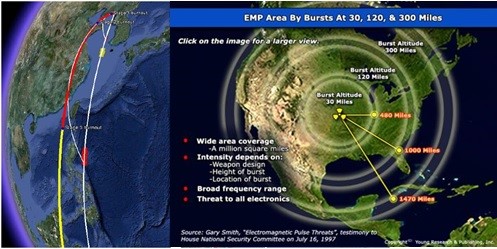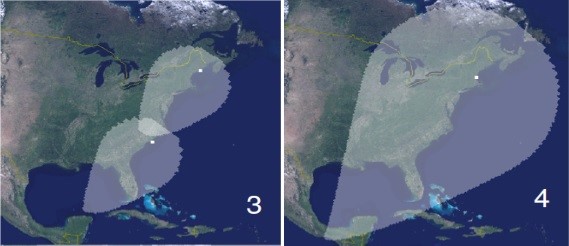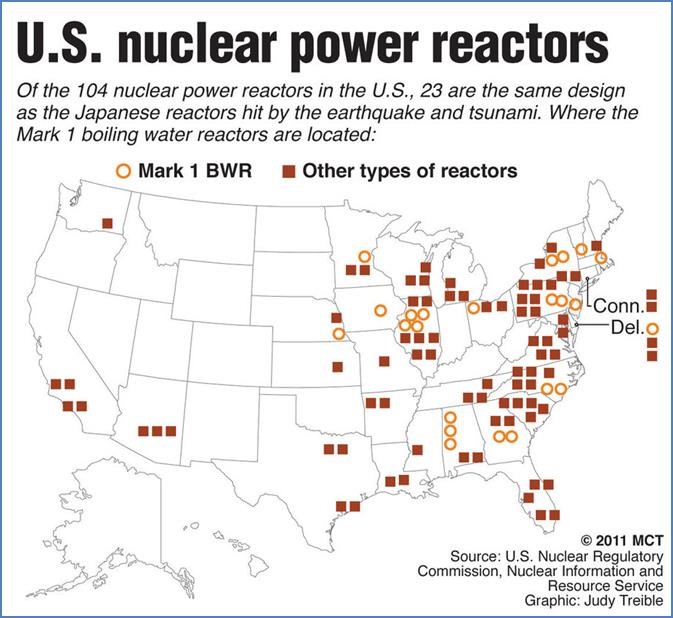Amb. Henry F. Cooper, Chairman . . . Lt. Gen. Daniel Graham, Founder
High Frontier . . Building Truly Effective Defenses . . Reagan’s Vision Lives
E-Mail Message 130716
Time for Action to Counter EMP!
By Ambassador Henry F. Cooper
July 16, 2013
An existential electromagnetic pulse (EMP) threat is posed by a natural event (a massive solar emission that is infrequent but certain to occur—the only question is when) or a manmade event produced by a high altitude nuclear explosion that could be executed by a number of nation states or even terrorists. Recent events suggest a growing appreciation of the seriousness of these threats and possibly the initiation of helpful countermeasures. But will they be in time?
Solar Storms and Space Weather.
The informative schematic below, from a major 2-page article on “Space Weather” in the Business Section of last Sunday’s Washington Post, indicates the scale of a massive solar emission called a Coronal Mass Ejection (CME), which creates a massive highly charged plasma cloud that, depending on orbital mechanics, can interact with the earth’s geomagnetic field to produce a long wave length EMP.
EMP from a major event would interact with a number of our critical infrastructures—including communications, transportation, and most importantly, the electric power grid. The EMP would couple to the long lines of the grid, producing a surge of energy on major power stations, with the potential to shut down the grid over large geographical regions. In 1989 a significant event caused the collapse of the grid over the entire province of Quebec, leaving six million Canadians without power for nine hours. The Quebec grid collapse was more than a minor annoyance but was caused by a solar event of only moderate intensity. Much larger solar EMPs are possible—the only question is when. A big CME missed us by a week in July 2012, according to Daniel N. Baker of the University of Colorado. The number of solar CMEs peaks every eleven years. The peak of the current eleven-year cycle extends through the rest of 2013; so, we have not yet “dodged the bullet” in this cycle.
The Post discussed a recent study by Lloyds of London, which was presented at a well-attended international conference in Washington. Lloyds concluded, among other things, that if a major emission impacting the northeastern U.S. were to knock out 20 of our high voltage transformers the consequences could be “extremely concerning,” and 40-million people living in the Northeast might have to go without power indefinitely. It would take many months or years to replace the key transformers, which are not produced in the U.S.
Lloyds of London is, of course, interested in how the insurance industry should view the risk and adjust to the possibility of major “solar storms” impacting North America (and presumably also the United Kingdom). This is an encouraging sign, which U.S. industrial leaders should emulate. I was also impressed to learn from reports of the proceedings of the international conference that U.K. and Israeli authorities have assigned a single agency to deal with this problem—a step that the U.S. powers that be should take to bring focus to the currently dysfunctional U.S. interagency process. As we have repeatedly urged, I believe the Energy Department is a good candidate for taking that leading role—and hope that Dr. Ernest Moniz, our new Energy Secretary, will take the initiative to assume that leadership role.
When (not if) we experience an event of the magnitude experienced in 1859—a so-called Carrington event, anticipated every century or so—the entire nation could lose electric power for an indefinite period, unless the power grid has been hardened against such an event. That possibility could lead to the death of several hundred million Americans, according to testimony from the congressionally mandated EMP Commission—many years ago, but so far, the “powers that be” have not acted to deal with this existential threat.
Clearly, the relatively inexpensive investment to harden the grid against this event certainly would be prudent. As we discussed on June 21, Rep. Trent Franks (R-AZ) and a dozen co-sponsors—from both political parties—have introduced HR2417, referred to as the Shield Act, to mandate that the electric power industry prepare to deal with this existential threat. Hopefully, they will be more successful in the current congress that in the last, which let the last proposed Act die in the House Energy and Commerce Committee. (All help from the grass roots would be welcome).
Countering Looming Ballistic Missile Threats.
The right panel of the chart below illustrates the EMP coverage for a nuclear weapon detonated above the United States, for three burst altitudes. The left hand panel illustrates the North Korean launches to their south to place satellites into orbits over the South Pole—Iran also has launched satellites into orbit over the South Pole. Either could use such a satellite to carry a nuclear weapon and detonate it a couple hundred miles over the central U.S. to create the EMP of concern over the entire continental U.S.
In addition to the same long wavelength effects as in a Carrington Event, a nuclear explosion would also create shorter wavelength effects that could cause additional damage to key components of electronic systems in general—everything from the electronic ignition in our automobiles to electronics essential to other means of transportation, health care, communications, banking, manufacturing, etc. And without electric power and the possibility of its timely restoration, this additional loss would add significantly to the chaos that would envelop all of society as we know it. If the Shield Act is passed and executed competently, then the power grid should be viable if exposed to all wavelength components of the nuclear produced EMP.
Appropriate hardening and stockpiling spares of key components for easy replacement can significantly reduce the related vulnerabilities for all these conditions. But sound planning, deployment and maintenance practices are essential to assure limited or no losses in case of a high altitude nuclear attack.
Effective ballistic missile defense (BMD) systems are important in countering the effects of nuclear-EMP attack, whether by satellite, intercontinental ballistic missiles (ICBMs) or short range ballistic missiles launched from vessels off our coasts. Given last week’s test failure of the ground-based interceptor (GBI) system, and the time usually required to determine the cause of the failure and execute a re-test of the rectified system, it makes sense to look for ways to augment the capabilities of the GBI system in Alaska and California. An anticipated Defense Department Report to Congress should carefully examine all these possibilities for the full combination of EMP threats.
As some of my colleagues and I have often argued, the easiest and least expensive way to employ additional interceptors to defend the East Coast from North Korean or Iranian ICBMs that approach the U.S. from the north is to augment the GBI system with Navy Aegis BMD capabilities. All that is required to achieve this objective is up-range radars to provide a cue to the existing Aegis cruisers and destroyers that are essentially always operating or in port along our East Coast. Shown below, on the left, are footprints that could be met by the currently deployed SM-3 IA or IB interceptors if supported by two X-band TYP-2 radars located as indicated by the dots. On the right is a footprint that should be met by the SM-3 IIA when it is deployed, now planned for 2017 in Poland. Note: One TYP-2 radar would be required in this case.
Some critics claim that these operations would require the Navy to perform picket ship duty. But such claims greatly exaggerate the needed modification of normal day-to-day Navy operations when in or near U.S. coastal waters. For example, on an average day last year, a couple of Aegis BMD ships were operating off our East Coast, and another six Aegis cruisers or destroyers were either in an East Coast port or maintenance depot. It is anticipated that these numbers will grow, in the near future by a factor of two while the fleet is in a major modernization cycle. Thus, in the near future, it seems entirely plausible that Aegis BMD ships with the SM-3 IA or IB, currently operating along the East Coast (or in port), could easily train to protect the U.S. against ICBMs launched from North Korea or particularly Iran.
The Aegis BMD ships are also capable of defending against short, medium and intermediate range ballistic missiles that might be launched from nearby vessels off our East Coast. Indeed, the Aegis BMD system has successfully been tested against all three ballistic missile types—and has an overall 26-out-32 success record—including shooting down a satellite traveling in outer space faster than an ICBM. In a few years these interceptors will be replaced with the more capable IIA with its larger footprint.
Finally, it should be noted that an alternative to Aegis at sea (currently funded to grow to 35 Aegis BMD ships by 2015) can be complemented by Aegis Ashore being deployed in Romania (2015) and Poland (2017) to help defend our NATO allies. This possibility should clearly be pursued to defend Americans around the Gulf of Mexico because our Aegis BMD ships do not operate in the Gulf. Gaps in our defenses along the Eastern Seaboard could also be filled with Aegis Ashore sites, e.g., on Ft. Dix, NJ or Camp Lejeune, NC or Kings Bay, GA.
Protecting Nuclear Reactors Deserve Top Priority!
Following a massive Geomagnetic Disturbance (GMD) from either a CME or a high altitude nuclear burst over the center of the United States, many U.S. nuclear power plants and their associated spent fuel pools could be without commercial grid power for 1-2 years—because of the loss of key transformers which are not produced in the United States. In the worst case, they might never arrive from where they are produced in Germany, South Korea or Japan—because our transportation system relies on electricity that no longer may be available if the electric power grid is lost.
This loss of Nuclear power reactors would constitute the loss of about 20-percent of the U.S. electric power capacity. But nuclear reactor power loss is only a part of the problem if the rest of the power grid is also lost. The consequences of losing cooling water for lack of electric power could be comparable to—or worse than—the March 11, 2011 earthquake-tsunami event causing a cascading failure in which 3 of the 6 reactors at the Fukushima Power Plant experienced full meltdown; and the overall radiation release was carried by the winds to contaminate much of the surrounding region all the way to Tokyo. This Category 7 event on the International Nuclear Event Scale (INES) is the same as that assigned to the 1986 Chernobyl Ukraine event, but the Fukushima event released much less radiation with less fatal consequences.
Because of the density of nuclear power plants from the central United States to the East Coast, the loss of cooling water at many of those sites would be far more horrific than Fukushima—beyond the impact of losing the electric power.
As shown in the figure above, all but eight nuclear power reactors (at 65 sites in 31 states) are located in the eastern half of the U.S. The loss of electric power at two thirds of these sites, suggested by some studies, could expose a major proportion of the U.S. population to radiation effects, given the variable weather patterns that would distribute the radiation. Click here to monitor the current wind flow pattern to your local area.
Working in this environment could be more than a little problematic, even for those prepared to employ the means of survival that were common in the 19th century.
The Nuclear Regulatory Commission (NRC) should evaluate the risks and potential countermeasures that they can assure are employed within their jurisdiction to assure public safety in the event of an EMP event. At a minimum, they should be better prepared technically to deal with the issues than most of the dysfunctional government organizations reviewed in our February 25th email. If they do their job regarding public safety and the nuclear power industry maybe other stodgy bureaucracies in Washington will follow suit and also do theirs regarding the entire electric power grid.
Bottom Lines.
A number of things are moving in the right direction to assure that the existential EMP threat is being recognized.
- It is hard to miss the prominence of a two full page article in the Business section of the Washington Post on “Solar Weather”—noting that businesses are recognizing their interests are at stake. This recognition should lead to activities and incentives to motivate the “powers that be” to address the interests of the private sector—and the rest of us as well.
- A recent major international conference focused on the same concern indicates that at least some nations are taking this concern seriously—the U.K. and Israel have designated single organizations to spearhead their response in dealing with the issue—a step the U.S. should follow.
- Thanks to the efforts of Maine State Representative Andrea Boland and all but two of her legislative colleagues in the Senate, Maine became the first state in the nation to pass legislation to seek to assure the electric power grid in its jurisdiction can survive a major natural or man-made EMP event.
- Dr. Ernest Moniz, in his confirmation hearing, promised that he would look into the issue of hardening the electric power grid to both natural and manmade EMP threat—hopefully, he will shortly follow through and assume a leadership role in countering these threats. Such an effort should factor in the role and concerns of the Nuclear Regulatory Commission.
- The Shield Act, recently again tabled by Rep. Trent Franks, will, if implemented this time by the current congress, formalize requirements for the electric power industry to harden the electric power grid.
- The Senate Armed Services Committee included in its version of the National Defense Authorization Act (NDAA) the requirement for Secretary of Defense to provide a Report to Congress assessing the ability of current BMD systems to defend the U.S. homeland, including against threats from vessels off our coasts, in particular from the Gulf of Mexico, and from other threats from the south.
- Such a report, if based on a rigorous assessment of the threat and possible counters to that threat, can’t possibly miss the important near term ways that the Aegis BMD systems—at sea and on shore—can add significantly to our current homeland defense capabilities for relatively minor funding.
- Major improvements are possible—the only question is whether we have time to rectify current shortcomings before we are threatened by an event that could send us back to the 19th century without the benefits of an agrarian society. This concern is highlighted by Israeli Prime Minister Netanyahu’s comments on Sunday’s Face the Nation interview—e.g., that Iran is “edging up to the red line . . . They haven’t crossed it yet. They’re also building faster centrifuges that would enable them to jump the line, so to speak, at a much faster rate – that is, within a few weeks.” And last week, the Defense Department’s National Air and Space Intelligence Center reported that “Iran could develop and test an ICBM capable of reaching the United States by 2015.”
- We need to redouble our efforts to counter this growing nuclear-armed ballistic missile threat!
High Frontier Plans.
We at High Frontier will continue to inform the powers that be of existential threats to the American people—as we have discussed in our emails for many months—and to urge them to “provide for the common defense” as charged by the Constitution they are sworn to uphold. Hopefully, key federal authorities and members of congress will soon begin to deal more effectively with this existential threat—in undertaking both the Shield Act and efforts to enhance our ballistic missile defenses, especially for our citizens on the East Coast and especially around the Gulf of Mexico, where they are completely vulnerable to ballistic missiles launched from vessels in the Gulf—or from Latin America, e.g., Venezuela.
We will also be taking the message to grass roots America. Our local and state authorities need to understand these issues and what they might do if their federal representatives continue to fail “to provide for the common defense.”
And what can you do?
Join us at High Frontier in seeking to alert the public and your local and state authorities to the existential threats posed by both man-made and natural EMP events—and what can be done about these threats.
We can use your help in spreading this information to the grass roots and to encourage all “powers that be” to provide for the common defense as they are sworn to do. Will you do your part?
Begin by passing this message to your friends and suggest they visit our webpage, www.highfrontier.org for more information. Also, please encourage your sphere of influence to sign up for our weekly e-newsletter!
Please click here to read Past Weekly Updates!
Please click here to read past Flash Messages!
Please help High Frontier continue this important and timely work!
Be sure to follow us on our Social Sites!
If you found this letter via our Social Sites, and you would like to subscribe, click below!










